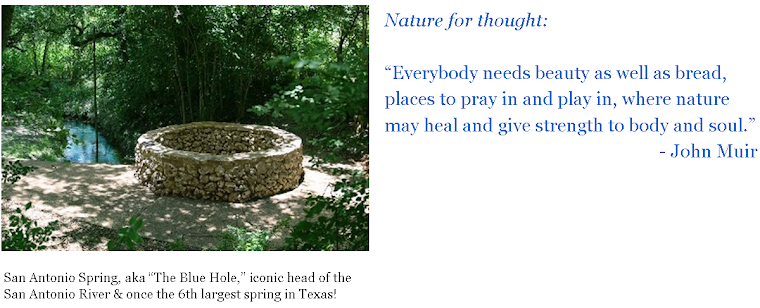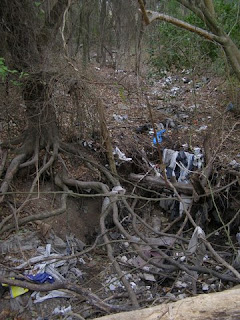Faith in the Workplace
Last Sunday, I was Lector in church and read aloud the following passage from Paul's Letter to the Ephesians.
The First Lesson—Ephesians 5:8-14
For once you were darkness, but now in the Lord you are light. Live as children of light--for the fruit of the light is found in all that is good and right and true. Try to find out what is pleasing to the Lord. Take no part in the unfruitful works of darkness, but instead expose them. For it is shameful even to mention what such people do secretly; but everything exposed by the light becomes visible, for everything that becomes visible is light. Therefore it says, "Sleeper, awake! Rise from the dead, and Christ will shine on you."
This bit of scripture spoke directly to a situation confronting me in my place of work at the Headwaters. The situation is one of those ethical dilemmas that confront us in our everyday life, except this one was a really big one involving very powerful forces. For some time I'd been asking myself: do I avert my eyes, close my mind, squelch my heart, avoid controversy, be silent and try to ignore the consequences? Or do I use what I know, find courage, act on what I believe is right, speak my truth, risk making enemies, and in the process, put other peoples' lives into turmoil along with my own?
What to do? Answer:
"Try to find out what is pleasing to the Lord.
Take no part in the unfruitful works of darkness,
but instead expose them."
My job as Headwaters Director is rooted in incarnational spirituality: the Incarnate Word, the Word made flesh; God's Word lived out in the flesh and blood of our daily lives. The Incarnate Word Sisters work through prayer and action to bring God's healing love into the world. This is their founding charism (or spiritual character) and it permeates every ministry they have ever founded.
Sometimes, the spiritual turns political, and then even judicial.
And when it does, look out.
Last week, the Headwaters Coalition with the support of the Incarnate Word Sisters joined the River Road Neighborhood Association in a legal attempt to restrain the San Antonio City Council from voting on the construction of a massive storm sewer in the San Antonio River in Brackenridge Park below the Hildebrand Bridge. Council's agenda included a $12 million contract to begin construction as soon as Mulberry Street is reopened to through traffic, possibly later this month (April). Judge David Berchelmann denied our request for a Temporary Restraining Order (TRO), but only because he did not believe he had authority to interfere with the legislative process when no immediate “irreparable harm” would ensue from the vote itself. Fair enough.
The City attorneys, the Judge and our own counsel, led by trial attorney Matt Wymer and attorney Bebb Francis, then agreed on the spot to a Temporary Injunction hearing set for Monday, April 11, just ten days hence. A Temporary Injunction (TI) hearing is an evidentiary hearing with witnesses, but the Judge's decision regarding a TI centers on whether it is essential to maintain the status quo (i.e., no construction) while a trial on the merits is pending. If successful, a TI would temporarily prevent construction on the storm sewer until the case is heard. Success at the later trial would result in a Permanent Injunction, stopping the Hildebrand outfall from ever being built.
And that, my friends, is our #1 goal in all this:
to keep the giant storm sewer
out of the sacred headwaters
of the San Antonio River.
A panoramic view of the San Antonio River at its northernmost point in Brackenridge Park where the city wants to put two 6x9 foot box culverts with a 70-foot concrete wall in this narrow, natural, historically very sensitive part of the river.
An existing 48" drainage conduit can be seen next to the Hildebrand Bridge at left.
Miraflores Park, a federally protected National Historic Place, is in the background.
Remnants of the old Spanish colonial acequia system are just behind the viewer.
This is one of those historic moments
when as a community we can choose...
to hold on to something truly unique, something ennobling to our spirits and fitting to our San Antonio heritage, something that lifts up and cherishes our river all the way from its physical and spiritual source to its living Mission churches in the south, something that honors our history, protects our central public park, restores our river's natural beauty, and preserves the public trust.
On the other hand, if we act with fear, we can choose to let it go, to stand aside while a destructive force is loosed on and in our river at its most vulnerable, historically rich, sacred location in the headwaters basin.
To hold on to and work together to realize the vision of a final “Spiritual Reach of the San Antonio River” is a golden opportunity that will be lost. It is an opportunity to complete with an exclamation point ( ! ) the historic community-wide effort to restore our relationship with our river, still the lifeblood of our community. It is an opportunity to “put the head on the headwaters” of the San Antonio River Improvements Project, and to connect physically, spiritually, symbolically for all times a historic vitally important institution in San Antonio –the Incarnate Word Sisters – with the rest of the city, by way of the river! The same river that brought the Incarnate Word Sisters to San Antonio in the first place.
How? A very broken relationship between the citizens of San Antonio and their life-giving river led to outbreaks of cholera (water borne disease associated with sewage) that killed hundreds of San Antonio's early citizens. One of those cholera epidemics brought the founding Sisters to San Antonio in 1869 to establish the city’s first infirmary, which became our first hospital and which is now CHRISTUS Santa Rosa Health System.
The Sisters, through the Headwaters, have now offered a place, a project and the encouragement to help us heal our broken relationship with nature and the river
at its physical and spiritual source.
 |
| Map used at Visioning Workshop on the Spiritual Reach June 25, 2010 |
The vision for a Spiritual Reach of the San Antonio River acknowledges the historical significance and long-standing relationship of the human community to this river, for good and for bad. It celebrates the historical significance and long-standing relationship of the Incarnate Word Sisters to the City of San Antonio. The Spiritual Reach vision – if given the opportunity to be well executed -- benefits everyone: the river at its sacred source, the community at large, and the Sisters and all their ministries at the "Head of the River": university, retirement center and nature sanctuary.
To squander this evolving opportunity with a misguided ugly potentially illegal drainage project in a revered part of the river is intolerable. We will all live to regret it if the project goes forward. This is what this challenge is all about for us.
And if our legal challenge is successful,
the river will be protected, and that sacred public trust
between government and citizens
will be preserved.
These are both values worth standing up for. Even when the cost of doing so is high. The city’s Hildebrand drainage project is quite simply not the bond project voters approved. Not even close. To let it go unchallenged is to risk grave injury to the river at its headwaters in our public park -- and to give carte blanche to the City for any and all of our bond committee-vetted and citizen-approved bonds. That we believe is a very dangerous precedent.
We hope you will stand with us in standing down
this unfortunate mistake.
Come watch and be a supportive presence.
No eligibility requirements necessary!
Come to the old County Courthouse on
Monday, April 11 by 9:00 am
and join us for the hearing in
Judge Berchelmann's courtroom.
















